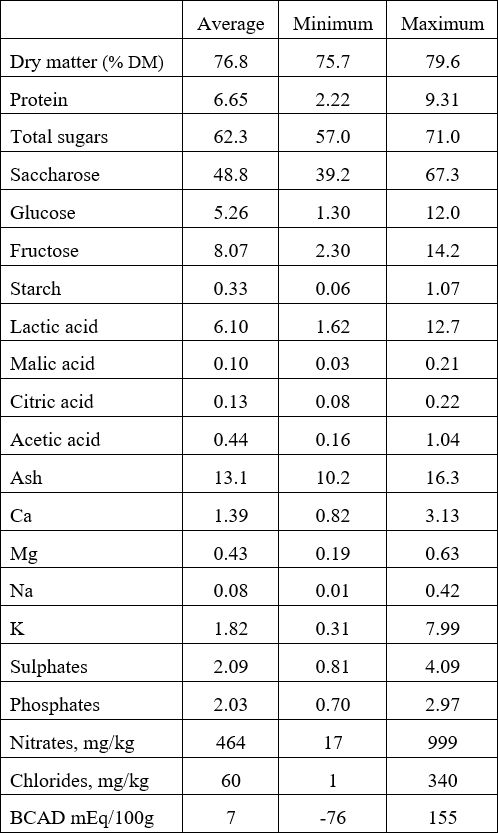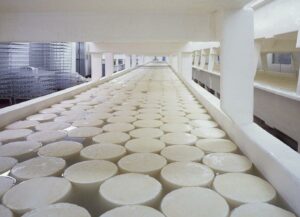Maria Villagrasa & Fernando Diaz
Molasses is a dense and blackish liquid obtained from the residue that remains in the vats after the sugar extraction from sugar beets and cane. It is a byproduct that is widely used worldwide in animal nutrition.
It has positive effects on the production of milk fat, ruminal ammonia and fiber digestibility. Molasses are usually added in limited amounts to the diet, to increase its palatability and dry matter intake since their main components are sugars, and animals prefer sweetened diets.
In general, its nutritional composition is not fully characterized by the literature and data on some of its components are missing such as organic acids. In order to expand the information on this, a study was carried out (Palmonari et al., 2020) to better characterize the composition of sugar cane and beet molasses, highlight possible differences, and obtain an adequate definition of such foods.
To this end, 16 cane and 16 beet samples were obtained worldwide and analyzed to determine their chemical composition. The results are presented in Tables 1 and 2.
Within the sugar cane molasses dry matter (DM) ranged from 75.7% to 79.6%, with an average of 76.8%. An average of 78.3% DM was observed in beets, with a minimum of 74.1% and a maximum of 78.9%. The ash content was higher in cane (13.1% DM) than in beet molasses (11.7% DM), with a maximum of 18.5% DM and a minimum of 6.5% DM in the latter.
Protein concentration was 6.7 and 13.5% DM in cane and beet molasses, respectively, ranging from a minimum 2.2% DM for cane to a maximum 15.6% DM for beet molasses. This difference could be related to specific molecules found in sugar beets, such as betaine, a nitrogenous compound that promotes growth and modulates lipid accumulation.
The most abundant sugar was sucrose
The sugar profile was different between the samples, with sucrose as the most abundant in both molasses types, although its concentration varied in each. In cane molasses the average was 48.8% of DM, varying from 39.2% to 67.3%. In beet molasses the concentration was higher (60.9% of DM), with a minimum of 46.5 and a maximum of 66.1% of DM. Glucose and fructose had average concentrations of 5.29 and 8.07% DM, respectively in cane molasses, and were barely detectable in beet molasses (0.30% DM on average).
Other sugars analyzed (galactose, raffinose, arabinose and xylose) were almost undetectable, and even the sum of the maximum values was less than 1.00% DM in cane molasses. The only exception was raffinose in beet molasses, with a concentration of 0.60% DM on average, and a maximum value of 2.18% DM. The reasons for these discrepancies could be related to the extraction process, as well as to the origin of the molasses. Starch had an average concentration of 0.33% DM in cane molasses, while in beet molasses was 0.08% DM.
The concentration of lactic acid was higher in cane molasses
Differences in organic acids were also observed. The concentration of lactic acid was higher in cane than in beet molasses (6.10 and 4.51% DM, respectively), ranging from a minimum of 1.62% to a maximum of 12.8% DM between cane molasses.
Aconitic acid was found only in cane molasses (1.42% DM), while glycolic acid was only found in beet molasses (0.25% MS). Other acids analyzed (acetic, butyric, propionic, citric, malic, formic and oxalic) had little representation in both molasses. Organic acids are not usually quantified when molasses is added to the diet. However, considering their variability, these fractions should be determined because they could affect rumen metabolism, and have a different impact on animal health and performance.
Difference between the electrolyte balance of the molasses
Sulphates, phosphates and chlorides had a higher concentration in cane molasses, which showed a numerically lower dietary cation-anion (BCAD) balance compared to beet molasses (7.0 vs. 66 mEq/100 g DM). The BCAD concept is based on the principle of electroneutrality and postulates that an entry of any cation or anion into the animal causes an alteration of the acid-base status. In the case of dairy cows fed an anionic diet, for example, it has more anions than cations. Absorption and distribution of negatively charged ions occur in the organism such that the animal needs positively charged ions to neutralize the entry of anions, which will otherwise lead to metabolic acidosis.
In the analysis of the molasses within the cane group, the BCAD ranged from 76 to +155 mEq/100 g of DM and from 0 to +162 mEq/100 g of DM in beet molasses. The variability of the BCAD observed in the samples underscores the importance of this determination when molasses is added to the diet. Even with a similar amount of total sugars, different types of molasses could have a completely different anion:cation ratio, with possible effects on animal health and performance.
Conclusion
Together these results show that there is a wide variability between samples and even within the same group, particularly in cane molasses indicating that there are differences in composition between molasses. Therefore, it is not enough to define a molasses by its origin, such as cane or beets, to properly assess its nutritional value. Molasses is a good source of fermentable sugars, but other components are also present, with potential effects on animal health or production.
Table 1. Nutritional composition (% DM) of sugar cane molasses.

Table 2. Nutritional composition (% DM) of sugar beet molasses.

Reference
Palmonari A, Cavallini D, Sniffen CJ, Fernandes L, Holder P, Fagioli L, Fusaro I, Biagi G, Formigoni A, Mammi L. Short communication: Characterization of molasses chemical composition. J Dairy Sci. 103. 10.3168/jds.2019-17644.
© 2020 Dairy Knowledge Center. All Rights Reserved.









